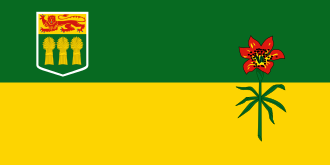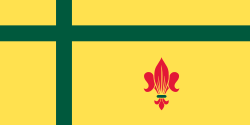Flag of Saskatchewan
 From Wikipedia - Reading time: 8 min
From Wikipedia - Reading time: 8 min
 | |
| Use | Civil and state flag |
|---|---|
| Proportion | 1:2 |
| Adopted | 22 September 1969 |
| Designed by | Anthony Drake |
The provincial flag of Saskatchewan was adopted in 1969. Its upper half is green and contains the coat of arms of Saskatchewan, and its lower half is yellow. In the fly of the flag is a western red lily, the provincial flower. In 2017, The Minister of Parks, Culture and Sports designated September 22 as Saskatchewan Flag Day.[1]
Design
[edit]The flag is blazoned: Per fess vert and or, in the fly a prairie lily slipped and leaved proper, in the dexter chief an escutcheon of the coat of arms of Saskatchewan fimbriated argent.
The green upper half represents the province's forested north, while the yellow represents the grain fields found in the south. The red prairie lily is the provincial flower of Saskatchewan.[2]
History
[edit]The flag of Saskatchewan was adopted on September 22, 1969, the result of a province-wide competition that drew over 4000 entries. The winning entry was one of the 13 designed by Anthony Drake of Hodgeville, Saskatchewan. Drake came and left Saskatchewan from the United Kingdom and did not have an opportunity to see his winning design fly until returning to Hodgeville.[3] Saskatchewan politician Percy Schmeiser was on the flag committee in 1969 during his time as member of the Legislative Assembly and was at the inaugural flag raising ceremony, unlike Anthony Drake. The two finally met when Drake returned in 2019.[4]
Other flags
[edit]
60th anniversary flag
[edit]In preparation for the province's Diamond Jubilee in 1965, the government organized a competition to design a distinctive flag utilizing the colours of the province's coat of arms. Sister Imelda of St. Angela's Convent of Prelate designed the winning flag, and it was selected from 241 other entries. The flag was first hoisted on 31 January 1965. Its use continued as the province's flag for the Canadian Centennial in 1967, and in the years prior to the selection of the current flag Sister Imelda's was used as well. The flag's sponsors hoped it would officially be the province's flag, as it was being used to represent Saskatchewan, but that was not the case.
The Diamond Jubilee flag is blazoned per fess gules and vert, in the fly an escutcheon of the Arms of Saskatchewan fimbriated or, in the hoist a stalk of wheat or. The red in the top half symbolizes the fires that used to rage through the prairies in the years before cultivation, the green represents the luxuriant growth, and the gold representing the ripening the wheat fields.[citation needed]
Fransaskois flag
[edit]
This flag used to represent the heritage of the French speakers of Saskatchewan and is blazoned Or a cross enhanced throughout vert, its vertical beam to the hoist, in the fly a fleur-de-lis gules its traverse vert.[5]
The symbolism within the Fransaskois flag is mostly the same as the provincial flag with the yellow and green representing the wheat and the forests respectively. However, with the addition of the cross alluding to the role that the Catholic Church and the many missionaries had in settling what is now the province of Saskatchewan and the fleur-de-lis which represents the Francophone population globally; it is coloured red to show the fighting courage in the battle of preserving the rights of their culture and language; it makes the flag distinguishable enough to stand out on its own.[5]
Standard of the lieutenant governor of Saskatchewan
[edit]
The lieutenant governor of Saskatchewan is a viceregal representative of the monarch of Canada and thus has their own flag. It has precedence over any other flag except the royal standard and the flag of the governor general of Canada, unless the governor general is a guest of the lieutenant governor. This flag is flown at the home and office of the lieutenant governor as well as any buildings that may conduct official duties.
It is blazoned Azure the shield of Arms of the Province of Saskatchewan ensigned with the Royal Crown proper and encircled by a wreath of maple leaves Or.[6]
Gallery
[edit]-
Flag of the Fransaskois
-
The Vice Regal Standard over the Saskatchewan Legislative Building at the installation of W. Thomas Molloy
-
Flag of the lieutenant-governor of Saskatchewan (1906–1981)
See also
[edit]References
[edit]- ^ "Special Days/Jours Spéciaux" (PDF). The Saskatchewan Gazette. 113 (37): 1748. September 15, 2017. Retrieved 2020-05-19.
- ^ The Governor General of Canada, Her Excellency the Right Honourable Julie Payette (15 November 2010). "Province of Saskatchewan". Retrieved 15 February 2022.
- ^ Chabun, Will (11 May 2016). "The weird and wonderful story of Saskatchewan's provincial flag". Regina Leader-Post. Retrieved 18 September 2019.
- ^ Millar, Ceilidh (19 July 2019). "Saskatchewan flag pioneers meet for first time after 50 years". Global News. Retrieved 25 September 2019.
- ^ a b The Governor General of Canada, Her Excellency the Right Honourable Julie Payette (15 August 2018). "Fransaskois Flag". Retrieved 25 September 2019.
- ^ The Governor General of Canada, Her Excellency the Right Honourable Julie Payette (15 March 2005). "Lieutenant Governor of Saskatchewan". Retrieved 25 September 2019.
External links
[edit]- Flag of Saskatchewan in the online Public Register of Arms, Flags and Badges
- Saskatchewan – Flags of the World
 KSF
KSF


